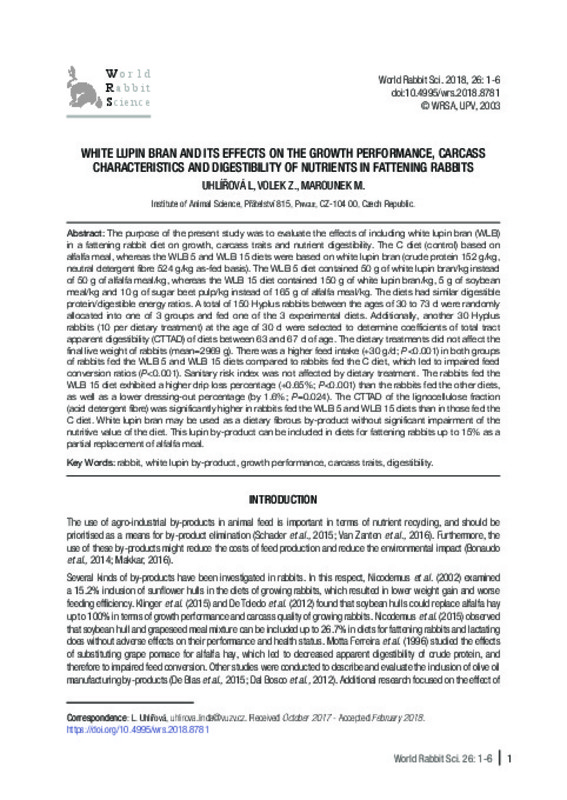JavaScript is disabled for your browser. Some features of this site may not work without it.
Buscar en RiuNet
Listar
Mi cuenta
Estadísticas
Ayuda RiuNet
Admin. UPV
White lupin bran and its effects on the growth performance, carcass characteristics and digestibility of nutrients in fattening rabbits
Mostrar el registro sencillo del ítem
Ficheros en el ítem
| dc.contributor.author | Uhlířová, Linda
|
es_ES |
| dc.contributor.author | Volek, Zdeněk
|
es_ES |
| dc.contributor.author | Marounek, Milan
|
es_ES |
| dc.date.accessioned | 2018-04-10T07:26:08Z | |
| dc.date.available | 2018-04-10T07:26:08Z | |
| dc.date.issued | 2018-03-28 | |
| dc.identifier.issn | 1257-5011 | |
| dc.identifier.uri | http://hdl.handle.net/10251/100092 | |
| dc.description.abstract | [EN] The purpose of the present study was to evaluate the effects of including white lupin bran (WLB) in a fattening rabbit diet on growth, carcass traits and nutrient digestibility. The C diet (control) based on alfalfa meal, whereas the WLB 5 and WLB 15 diets were based on white lupin bran (crude protein 152 g/kg, neutral detergent fibre 524 g/kg as-fed basis). The WLB 5 diet contained 50 g of white lupin bran/kg instead of 50 g of alfalfa meal/kg, whereas the WLB 15 diet contained 150 g of white lupin bran/kg, 5 g of soybean meal/kg and 10 g of sugar beet pulp/kg instead of 165 g of alfalfa meal/kg. The diets had similar digestible protein/digestible energy ratios. A total of 150 Hyplus rabbits between the ages of 30 to 73 d were randomly allocated into one of 3 groups and fed one of the 3 experimental diets. Additionally, another 30 Hyplus rabbits (10 per dietary treatment) at the age of 30 d were selected to determine coefficients of total tract apparent digestibility (CTTAD) of diets between 63 and 67 d of age. The dietary treatments did not affect the final live weight of rabbits (mean=2969 g). There was a higher feed intake (+30 g/d; P<0.001) in both groups of rabbits fed the WLB 5 and WLB 15 diets compared to rabbits fed the C diet, which led to impaired feed conversion ratios (P<0.001). Sanitary risk index was not affected by dietary treatment. The rabbits fed the WLB 15 diet exhibited a higher drip loss percentage (+0.65%; P<0.001) than the rabbits fed the other diets, as well as a lower dressing-out percentage (by 1.6%; P=0.024). The CTTAD of the lignocellulose fraction (acid detergent fibre) was significantly higher in rabbits fed the WLB 5 and WLB 15 diets than in those fed the C diet. White lupin bran may be used as a dietary fibrous by-product without significant impairment of the nutritive value of the diet. This lupin by-product can be included in diets for fattening rabbits up to 15% as a partial replacement of alfalfa meal. | es_ES |
| dc.language | Inglés | es_ES |
| dc.publisher | Universitat Politècnica de València | |
| dc.relation.ispartof | World Rabbit Science | |
| dc.rights | Reserva de todos los derechos | es_ES |
| dc.subject | Rabbit | es_ES |
| dc.subject | White lupine by-product | es_ES |
| dc.subject | Growth performance | es_ES |
| dc.subject | Carcass traits | es_ES |
| dc.subject | Digestibility | es_ES |
| dc.title | White lupin bran and its effects on the growth performance, carcass characteristics and digestibility of nutrients in fattening rabbits | es_ES |
| dc.type | Artículo | es_ES |
| dc.date.updated | 2018-04-10T07:05:37Z | |
| dc.identifier.doi | 10.4995/wrs.2018.8781 | |
| dc.rights.accessRights | Abierto | es_ES |
| dc.description.bibliographicCitation | Uhlířová, L.; Volek, Z.; Marounek, M. (2018). White lupin bran and its effects on the growth performance, carcass characteristics and digestibility of nutrients in fattening rabbits. World Rabbit Science. 26(1):1-6. https://doi.org/10.4995/wrs.2018.8781 | es_ES |
| dc.description.accrualMethod | SWORD | es_ES |
| dc.relation.publisherversion | https://doi.org/10.4995/wrs.2018.8781 | es_ES |
| dc.description.upvformatpinicio | 1 | es_ES |
| dc.description.upvformatpfin | 6 | es_ES |
| dc.type.version | info:eu-repo/semantics/publishedVersion | es_ES |
| dc.description.volume | 26 | |
| dc.description.issue | 1 | |
| dc.identifier.eissn | 1989-8886 |








